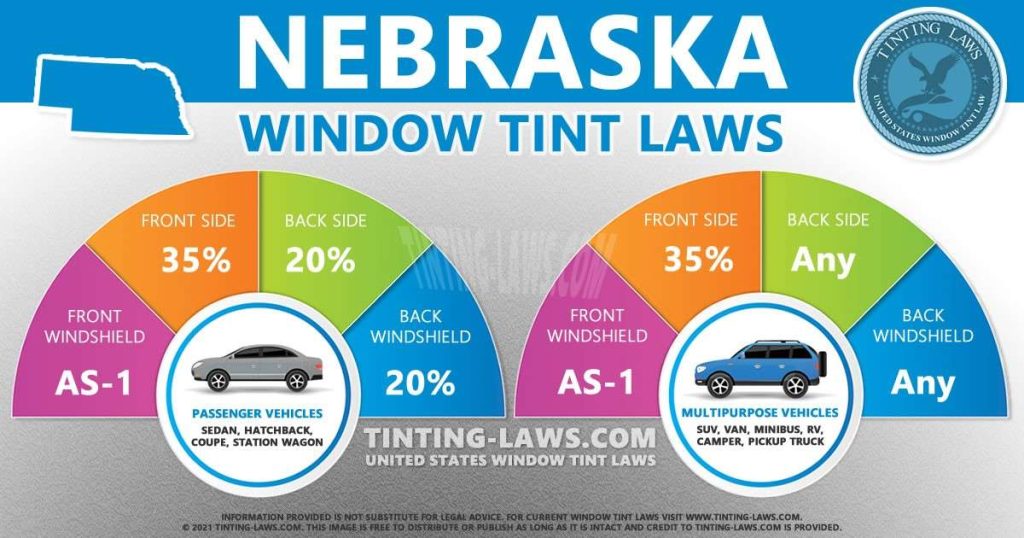Nebraska Window Tinting Laws
| Nebraska Window Tint Law: | ||
|---|---|---|
| Sedan | MPV | |
| Windshield | AS-1 | AS-1 |
| Front Side | 35% | 35% |
| Back side | 20% | Any |
| Rear window | 20% | Any |
Nebraska window tint laws restrict windshield tint above AS-1 line.
Front side windows must have 35% light transmission or more.
Back side windows and rear window may have 20% VLT on passenger vehicles, or any darkness on SUVs and other multi purpose vehicles.
Car window tinting laws in Nebraska were enacted in 2006.
We have provided all the necessary information about your car’s window tint, including how dark or reflective the tint is allowed in your state.
There are also additional car window tinting rules and regulations in Nebraska so make sure you read all about it below.
Window tint darkness in Nebraska
The percent of visible light allowed through your car windows is called VLT: Visible Light Transmission.
The percentage of light allowed through your film and glass in Nebraska is very specific and different for sedan cars and SUV cars or vans.
Tint darkness for sedans:
- Windshield: Non-reflective tint is allowed above the manufacturer’s AS-1 line.
- Front Side windows: Must allow more than 35% of light in.
- Back Side windows: Must allow more than 20% of light in.
- Rear Window: Must allow more than 20% of light in.
Tint darkness for SUV and vans:
- Windshield: Non-reflective tint is allowed above the manufacturer’s AS-1 line.
- Front Side windows: Must allow more than 35% of light in.
- Back Side windows: May have any darkness.
- Rear Window: May have any darkness.
Nebraska laws prohibit tinting windows where “ability to see into the motor vehicle is substantially impaired”.
This is very open to interpretation, so to be safe you may want to avoid tint less than 20% VLT on all vehicles.
Window tint reflection in Nebraska
Window tint can reflect incoming light and reduce glare and heat.
Nebraska window tint law permits a certain window reflection when using a tint so make sure you pay attention to this as well.
Tint reflection for sedans:
- Front Side windows: Must not be more than 35% reflective.
- Back Side windows: Must not be more than 35% reflective.
Tint reflection for SUV and vans:
- Front Side windows: Must not be more than 35% reflective.
- Back Side windows: Must not be more than 35% reflective.
Other Nebraska window tint rules and regulations:
Nebraska does have several other important laws, rules and regulations pertaining to window tinting. They include the following:
- Side Mirrors: Nebraska state law does not specify side mirror requirements.
- Restricted Colors: RED, AMBER and YELLOW colors are not permitted on windshields by Nebraska law.
- Certificates: Manufacturers of film do NOT need to certify the film they sell in the state.
- Stickers: No sticker to identify legal tinting is required.
- Medical Exceptions: Nebraska law does NOT allow medical exemptions that would allow you use special tint.
- Penalties: Class V misdemeanor.
Keep in mind that Nebraska tinting laws and regulations may be interpreted differently in your county or place of residence.
We always recommend double-checking our information with your local DMV or law enforcement authorities.

Our information about window tint laws in Nebraska was last updated in 2024.
Tinting laws in Nebraska were enacted in 2006.
In case any of our info provided is not up to date or correct be sure to contact us so we can fix it. Thanks!
Trusted industry leader in providing accurate window tint laws. Share with confidence:
State of Nebraska Info
Nebraska is a state on the Great Plains of the Midwestern United States.
Its state capital is Lincoln. Its largest city is Omaha, which is on the Missouri River.

The state is crossed by many historic trails, but it was the California Gold Rush that first brought large numbers of non-indigenous settlers to the area.
Nebraska became a state in 1867.
Capital: Lincoln
Population: 1,845,525
Area: 77,354 sq mi (200,520 km2)
Cities in Nebraska: Omaha, Lincoln, Grand Island, Papillion, Kearney, Monowi, North Platte, Scottsbluff, Bellevue, Fremont, Nebraska City, Clarks, Norfolk, Hastings, Boys Town, Wahoo, Columbus, Ogallala, Beatrice, Oshkosh, Cosmo Township, La Vista, Chadron, Sidney, Rising City, Alliance, Stocking Township, Elkhorn, McCook, York, Valentine, South Sioux City, Plattsmouth, Gering, Mapps, Broken Bow, Alvo, Peru, Blair, Lexington, Gretna, Gothenburg, Joder, Falls City, Seward, Wayne, Geneva, Crete, Aurora, Surprise
Counties in Nebraska: Adams, Antelope, Arthur, Banner, Blaine, Boone, BoxButte, Boyd, Brown, Buffalo, Burt, Butler, Cass, Cedar, Chase, Cherry, Cheyenne, Clay, Colfax, Cuming, Custer, Dakota, Dawes, Dawson, Deuel, Dixon, Dodge, Douglas, Dundy, Fillmore, Franklin, Frontier, Furnas, Gage, Garden, Garfield, Gosper, Grant, Greeley, Hall, Hamilton, Harlan, Hayes, Hitchcock, Holt, Hooker, Howard, Jefferson, Johnson, Kearney, Keith, KeyaPaha, Kimball, Knox, Lancaster, Lincoln, Logan, Loup, Madison, McPherson, Merrick, Morrill, Nance, Nemaha, Nuckolls, Otoe, Pawnee, Perkins, Phelps, Pierce, Platte, Polk, Red Willow, Richardson, Rock, Saline, Sarpy, Saunders, , Seward, ScottsBluff, Sheridan, Sherman, Sioux, Stanton, Thayer, Thomas, Thurston, Valley, Washington, Wayne, Webster, Wheeler, York
Tint law references:
Nebraska Revised Statutes section 60-6, 257: Windshields and windows; tinting; sun-screening